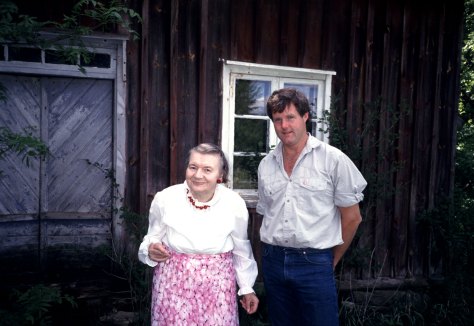
The first time I met Elsa was just a few months after she had come home to live with her mother. I was eight years old and my brother, Peter, was ten. In Sweden children sell books and magazines before Christmas to earn money. They have one or two catalogs and go door to door and take orders from people. Peter was doing this and on a visit to our cousins who lived on a farm outside of town, he decided he should bring his catalogs and try to sell something in that area. We were encouraged to visit all the farms in the neighborhood but, they said, don’t go to the little house in the forest. The ladies who live there are so poor, they wouldn’t have any money.
It was a dark afternoon in October, late enough in the year for people to begin to think about Christmas, but I think most of them had already placed their orders with someone else. I remember that we didn’t have much luck, if fact, we didn’t get any orders at all. We were pretty discouraged and thought that if we could just sell one little magazine we would be happy.
When we had been around to all the farms without any sales, my brother decided we should visit the two old ladies anyway. So we follow the path through the woods to the little house where they lived. It was dark and a little creepy when we walked up the overgrown path between the looming spruce trees. Soon we saw the gleam of an oil lamp in one of the windows of a small cabin. When we reached the stone steps we knocked cautiously on the door. The door opened and someone peeked out. When we told her why we had come, she invited us in. She stuttered and spoke with a loud, shrill voice, which frightened us a bit, but we gathered our courage and went inside the little house. The lady who invited us in was Elsa.
We showed her our catalogs and asked if she would like to order anything from us. Elsa asked us to come into the kitchen. (The cabin had three small rooms. Inside the door was a small hallway. On the right was the kitchen that was about 20-25 square feet. On the left, behind a thick blanket, was the bedroom.) Elsa looked through the catalogs and began to order. I think she ordered one of each of the books in the catalog. (We didn’t know that Elsa had just recently come home after 32 years in an asylum where she wasn’t allowed to own anything, not even a postcard) We were just pleased and happy that we had made a good sale on an otherwise discouraging and dark October evening.
We thanked her, put our catalogs into our little bag and were just about to leave when we heard an eerie, ghostly voice call from the bedroom, “Elsa does not want any books, she doesn’t have any money!” That spooky voice coming from behind the blanket was too much for two small boys. We burst out through the door and ran as fast as we could through the forest, not stopping until we reached the main road. There we stood for a moment to catch our breath and consider what had just happened before we slowly and dejectedly walked back to our cousins’ farm. We never told anybody about our encounter, neither did we order any books or magazines for Elsa.
Twenty-five years later I was commissioned to produce a documentary about Vårgårda and some of the interesting people who lived there. I had a long list of names of people I was supposed to interview. Working my way through the list I called each one and arranged a meeting. One of the names on the list was Elsa Lundh. I had not had any contact with her since that day when I was eight years old. I called Elsa and asked if I could come and film an interview with her. She said that would be great and we booked a time.
On the day of the interview I went to Elsa’s apartment, which was located near the center of town. I rang the doorbell and waited. It took awhile before I heard someone moving on the other side of the door and the sound of locks being opened. (Elsa was afraid of burglars so she had installed several extra locks on her door just to be on the safe side.) After several minutes I saw the doorknob turn and the door opened a crack. The opening widened just enough for a gnarled hand to reach through, one finger pointed right at me. Then I discovered the little hunch-backed woman inside. Before I could say a word I heard Elsa’s strong, shrill voice asking, ”Where are the books I ordered?”
Elsa forgave me, thank goodness. She understood why we hadn’t returned with the books she had ordered that Christmas in 1965. She also told me that she did, in fact, have money then. She had just begun to collect her pension.
More next week about working with Elsa. The movie “My Dear Elsa” tells her story from degradation to triumph. See it on DVD and Vimeo .


